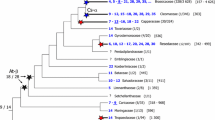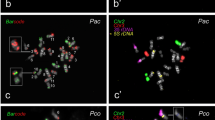Abstract
Robertsonian fusion and centric fission are uniquely detectable in comparative studies of karyotype patterns. They are the most important types of karyotype change in animals but seem to be relatively uncommon in higher plants. Both modify intra- and interchromosomal recombination and linkage relationships and consequently patterns of genetic variation. When differentiating populations or species they can produce postulating barriers to gene flow. The number of reported cases of fusion or fission in higher plants has increased over the years but remains low, and most of these are casual comparisons of karyotypes without any follow-up investigation. This review focuses on more adequate studies made in a few groups.
Studies in the Tradescantieae produce the strongest evidence for fusion as a type of orthoselection in the subfamily. Some species ofLycoris are also considered to have evolved their karyotypes in that way. Some genera of slipper orchids and the cycad genusZamia have populations where atypical chromosome number increase can be attributed to fission probably as a result of stressful influences.
It is suggested that fusion may have been involved in the evolution of many stable karyotypes and that fission is generally a secondary destabilizing mechanism which may lead to refusion in the long term. Their proven incidence remains making it unwise to suggest that they have been major influences in karyotype evolution in higher plants.
Similar content being viewed by others
Literature Cited
Bennett, M. D. &I. J. Leitch 1997. Nuclear DNA amounts in Angiosperms—583 new estimates. Ann. Bot. 80: 169–196.
Bidau, C. J. 1990. The complex Robertsonian system ofDichroplus pratensis (Melanoplinae: Acrididae). II. Effects of the fusion polymorphisms on chiasma frequency and distribution. Heredity 64: 145–159.
—. 1993. Causes of chiasma repatterning due to centric fusions. Rev. Brasil. Genet. 16: 283–296.
Brandham, P. E. 1976. The frequency of spontaneous structural change. Pp. 77–87in K. Jones & P. E. Brandham (eds.), Current chromosome research. North-Holland Publishing, New York.
—. 1983. Evolution in a stable chromosome system. Pp. 251–260in P. E. Brandham & M. D. Bennett (eds.), Kew Chromosome Conference II. Allen & Unwin, Boston.
Brighton, C. A. 1978. Telocentric chromosomes in CorsicanCrocus L. (Iridaceae). Pl. Syst. Evol. 129: 299–314.
Caputo, P., S. Cozzolino, L. Gaudio, A. Moretti &D. W. Stevenson. 1996. Karyology and phylogeny of some Mesoamerican species ofZamia. Amer. J. Bot. 83: 1513–1520.
Cox, A. V., S. T. Bennett, A. S. Parokonny, A. Kenton, M. A. Callimassia &M. D. Bennett. 1993. Comparison of plant telomere locations using a PCR-generated synthetic probe. Ann. Bot. 72: 239–247.
—,D. G. Abdelnour, M. D. Bennett &I. J. Leitch. 1998. Genome size and karyotype evolution in the slipper orchids (Cypripedioideae: Orchidaceae). Amer. J. Bot. 85: 681–687.
—,A. M. Pridgeon, V. A. Albert &M. Chase. 1997a. Phylogenetics of the slipper orchids (Cypripedioideae: Orchidaceae). Nuclear rDNA—its sequences. Pl. Syst. Evol. 208: 197–223.
—— &M. A. T. Johnson. 1997b. Cytological characterization ofMexipedium xerophyticum (Cypripedioideae: Orchidaceae). Lindleyana 12: 162–165.
Cribb, P. J. 1987. The genusPaphiopedilum. Collingridge, London.
Crosa, O. 1972. Estudios cariologia en el géneroNothoscordum (Liliaceae). Bol. Fac. Agr. Uruguay 122: 3–8.
Darlington, C. D. 1956. Chromosome botany. Allen & Unwin, London.
Gibby, M., S. Hinnah, E. Marais &F. Alben. 1996. Cytological variation and evolution withinPelargonium sect.Hoarea (Geraniaceae). Pl. Syst. Evol. 203: 111–142.
Goldblatt, P. 1979. Chromosome cytology and karyotype change inGalaxia (Iridaceae). Pl. Syst. Evol. 133: 61–69.
—. 1980. Uneven diploid numbers and complex heterozygosity inHomeria (Tridaceae). Syst. Bot. 5: 337–340.
Hair, J. B. 1963. Cytogeographical relationships of the southern podocarps. Pp. 401–414in J. L. Gressitt et al. (eds.), Pacific basin biogeography. Bishop Museum Press, Honolulu.
—. 1966. Biosystematics of the New Zealand flora, 1945–1964. New Zealand J. Bot. 4: 559–595.
— &E. J. Beuzenberg. 1958a. Chromosomal evolution in the Podocarpaceae. Nature 181: 1584–1586.
— 1958b. Contributions to the chromosome atlas of the New Zealand flora 1. New Zealand J. Sci. 1958: 617–628.
Hunt, D. R. 1980. Sections and series in Tradescantia. American Commelinaceae IX. Kew Bull. 35: 437–442.
Inariyama, S. 1932. Cytological studies of the genusLycoris 1. Conjugation of chromosomes in meiosis inL. albiflora Koidz. Bot. Mag. Tokyo 46: 426–434.
Jackson, R. C. 1962. Interspecific hybridization inHaplopappus and its bearing on chromosome evolution in theBlepharodon section. Amer. J. Bot. 49: 119–132.
John, B. &M. Freeman. 1975. Causes and consequences of Robertsonian exchange. Chromosoma (Berlin) 52: 123–136.
Jones, K. 1974. Chromosome evolution by Robertsonian translocation inGibasis. Chromosoma (Berlin) 45: 353–368.
— 1977. The role of Robertsonian change in karyotype evolution in higher plants. Pp. 121–129in A. de la Chapelle & M. Sorsa (eds.), Chromosomes today: Proceedings of the 6th International Chromosome Conference. Oliver & Boyd, Edinburgh.
— 1978. Aspects of chromosome evolution in higher plants. Adv. Bot. Res. 6: 120–194.
—. 1990. Robertsonian change in alliesof Zebrina (Commelinaceae). Pl. Syst. Evol. 172: 263–271.
— &S. Bhattarai. 1981. Contributions to the cytotaxonomy of Commelinaceae.Gibasis linearis and its allies. Bot. J. Linn. Soc. 83: 141–156.
— &A. Kenton. 1984. Mechanisms of chromosome change in the evolution of the tribe Tradescantieae (Commelinaceae). Pp. 143–168in A. Sharma & A. K. Sharma (eds.), Chromosomes in evolution of eukaryotic groups. CRC Press, Florida.
— &J. B. Smith. 1967. Chromosome evolution in the genusCrinum. Caryologia 20: 163–179.
—,D. Papes &D. R. Hunt. 1975. Contributions to the cytotaxonomy of the Commelinaceae II. Further observations onGibasis geniculata and its allies. Bot. J. Linn. Soc. 71: 145–166.
—,A. Kenton &D. R. Hunt. 1981. Contributions to the cytotaxonomy of the Commelinaceae. Chromosome evolution inTradescantia sect.Cymbispatha. Bot. J. Linn. Soc. 83: 157–188.
Karasawa, K. 1978. Karyomorphological studies on the intraspecific variation ofPaphiopedilum insigne. La Chromosomo II-9: 233–255.
—. 1979. Karyomorphological studies inPaphiopedilum, Orchidaceae. Bull. Hiroshima Bot. Gard. 2: 1–149.
—. 1980. Karyomorphological studies inPhragmipedium, Orchidaceae. Bull. Hiroshima Bot. Gard. 3: 1–49.
—. 1982. Karyomorphological studies on four species ofPaphiopedilum, Orchidaceae. Bull. Hiroshima Bot. Gard. 5: 70–79.
—. 1986. Karyomorphological studies on nine taxa ofPaphiopedilum. Bull. Hiroshima Bot. Gard. 8: 23–42.
— &M. Aoyama. 1986. Karyomorphological studies inCypripedium in Japan and Formosa. Bull. Hiroshima Bot. Gard. 8: 1–22.
— &R. Tanaka. 1980. C-banding study on centric fission in the chromosomes ofPaphiopedilum. Cytologia 45: 97–102.
Kenton, A. 1981a. Chromosome evolution in theGibasis linearis alliance. The Robertsonian differentiation of G.venustula andG. speciosa. Chromosoma (Berlin) 84: 291–304.
—. 1981b. A Robertsonian relationship in the chromosomes of two species ofHydrocleys (Butomaceae sens. lat). Kew Bull. 36: 487–492.
—. 1982. Chromosome evolution in Mexican species ofGibasis (Commelinaceae). Ph.D. thesis, Reading University, Reading, U.K.
—. 1984. Robertsonian differentiation and preferential pairing revealed in species and F1 hybrids of theGibasis linearis group (Commelinaceae). Pl. Syst. Evol. 144: 221–240.
—,A. Davies &K. Jones. 1987. Identification of Renner complexes and duplications in permanent hybrids ofGibasis pulchella (Commelinaceae). Chromosoma (Berlin) 95: 424–434.
—,S. J. Owens &D. Langten. 1988. The origin of ring-formation and self-compatibility inGibasis pulchella (Commelinaceae). Pp. 75–84in P. E. Brandham (ed.), Kew Chromosome Conference III. Her Majesty’s Stationery Office, London.
Khosboo, T. N. 1962. Cytogenetical evolution in the gymnosperms. Proc. Summer Sch. Bot. Darjeeling: 119–135.
— &M. R. Ajuha. 1963. The chromosomes and relationships ofWelwitschia mirabilis. Chromosoma (Berlin) 14: 522–533.
King, M. 1993. Species evolution—the role of chromosome change. Cambridge University Press, Cambridge.
Kokubugata, G. &K. Kondo. 1996. Differential fluorescent-banding in chromosomes of four species ofCycas (Cycadaceae). Bot. J. Linn. Soc. 120: 51–55.
Kollman, F. 1970. Karyotypes of threeAllium species of theerdelii group. Caryologia 23: 647–655.
Kondo, K., G. Kokubugata, M. Hizume, R. Tanaka &T. Satake. 1995. A karyomorphological study of five species and one variety ofCycas. Cytologie 60: 141–147.
Koyama, M. 1962. Meiosis inLycoris albiflora. Ann. Rep. Doshisha Women’s College 12: 9–12.
—. 1978. Chromosome pairing in the genusLycoris II. Ann. Rep. Doshisha Women’s College 29: 272–282.
Kurita, S. 1986. Variation and evolution in the karyotype ofLycoris I. General karyomorphological characteristics of the genus. Cytologie 51: 803–815.
—. 1987a. Variation and evolution in the karyotype ofLycoris II. Karyotype analysis often taxa among which seven are native in China. Cytologie 52: 19–40.
—. 1987b. Variation and evolution in the karyotype ofLycoris III. Intraspecific variation in the karyotype ofL. traubii Hayward. Cytologia 52: 117–128.
—. 1987c. Variation and evolution in the karyotype ofLycoris IV. Intraspecific variation in the karyotype ofL. radiata (L’Herit.) Herb, and the origin of this triploid species. Cytologie 52: 137–149.
—. 1988a. Variation end evolution in the karyotype ofLycoris VI. Intrapopulational and/or intraspecific variation in the karyotype ofL. sanguinea Maxim, var.kiushiana Makino and ver.koreana (Nakai) Koyeme. Cytologie 53: 307–321.
—. 1988b. Variation and evolution in the keryotypeof Lycoris VII. Modes of karyotype elteretion within species end probable trend of karyotype evolution in the genus. Cytologie 53: 323–335.
Kyhos, D. W. 1965. The independent aneuploid origin of two species ofChaenactis (Compositae) from a common ancestor. Evolution 19: 26–43.
Levan, A. &S. Emsweller. 1938. Structurel hybridity inNothoscordum fragrans. J. Hered. 29: 291–294.
—,K. Fredga &A. A. Sandberg. 1964. Nomenclature for centromeric position on chromosomes. Hereditas 52: 201–220.
Marchant, C. J. 1968. Chromosome patterns and nuclear phenomena in the cycad families Stangeriaceae and Zamieceae. Chromosome (Berlin) 24: 100–134.
Mattsson, O. 1971. Cytologicel observations within the genusZebrina. Bot. Tidsskr. 66: 189–227.
Maxted, N., M. A. Callimassia &M. D. Bennett. 1991. Cytotaxonomic studies of eastern MediterraneenVicia species (Leguminosae). Pl. Syst. Evol. 177: 221–234.
Moretti, A. 1990a. Karyotypic data on North end Central American Zamiaceae (Cycedales) and their phylogenetic implications. Amer. J. Bot. 77: 1016–1029.
—. 1990b. Cytotaxonomy of cycads. Mem. New York Bot. Gard. 57: 114–122.
— &S. Sabato. 1984. Karyotype evolution by centromeric fission inZamia (Cycadeles). Pl. Syst. Evol. 146: 215–233.
—,P. Caputo, L. Gaudio &D. W. Stevenson. 1991. Intraspecific chromosome variation inZamia (Zamiaceae, Cycadales). Caryologia 44: 1–10.
Moscone, A., M. Lambrou, A. T. Hunziker &F. Ehrendorfer. 1993. Giemsa C-banded karyotypes inCapsicum (Solanaceae). Pl. Syst. Evol. 186: 213–229.
Norstog, K. 1980. Chromosome numbers inZamia. Caryologia 33: 419–428.
—. 1981. Karyotypes ofZamia chigua (Cycedeles). Ceryologia 34: 255–260.
Nuflez, O. 1990. Evolucion ceriotfpicaen el géneroNothoscordum. Acad. Nac. Ca. Ex. Fis. Net., Buenos Aires. Monogr. 5: 55–61.
—,N. Frayssinet &R. Rodriguez. 1972. Los cromosomas deNothoscordum Kunth (Liliaceae). Darwinia 17: 243–245.
——— &K. Jones. 1974. Cytogenetic studies in the genusNothoscordum Kunth. I. TheN. inodorum polyploid complex. Caryologia 23: 235–254.
Parker, J. S. 1987. Increased chiasma frequency as a result of chromosome rearrangement. Heredity 58: 87–94.
—,A. S. Wilby &S. Taylor. 1988. Chromosome stability and instability in plants. Pp. 131–140in P. E. Brandham (ed.), Kew Chromosome Conference III. Her Majesty’s Stationery Office, London.
Redi, C. A., S. Garagna &E. Cappana. 1990. Nature’s experiment within situ hybridization? A hypothesis for the mechanism of Rb fusion. J. Evol. Biol. 3: 133–137.
Rousi, A. 1961. Cytotaxonomical studies onVicia cracca L. andV. tenuifolia Roth. Hereditas 47: 81–110.
Sax, K. &J. M. Beale. 1934. Chromosomes of the Cycadales. J. Arnold Arb. 15: 255–258.
Schubert, I. &R. Reiger. 1990. Alteration by centric fission of the diploid number inVicia faba L. Genetica 81: 67–69.
Stone, D. E. &J. L. Freeman. 1968. Cytotaxonomy ofIllicium floridanum andI. parviflorum (Illiceaceae). J. Arnold Arb. 49: 41–51.
Strid, A. 1968. Stable telocentric chromosomes formed by spontaneous misdivision inNigella doerfleri. Bot. Not. 121: 153–164.
Vovides, A. P. 1983. Systematic studies on the MexicanZamiaceae. I. Chromosome numbers and karyotypes. Amer. J. Bot. 70: 1002–1006.
— &M. Olivares. 1996. Karyotype polymorphism in the cycadlamia loddigesii (Zamiaceae) of the Yucatan peninsula, Mexico. Bot. J. Linn. Soc. 120: 77–83.
Weins, D. &B. A. Barlow. 1975. Permanent translocation heterozygosity and sex determination in East African mistletoes. Science 187: 1208–1209.
Werner, J. E., R. S. Kota, B. S. Gill &T. R. Endo. 1992. Distribution of telomeric repeats and their role in the healing of broken chromosome ends in wheat. Genome 35: 844–848.
White, M. J. D. 1945. Animal cytology and evolution. Ed. 1. Cambridge University Press, Cambridge.
—. 1973. Animal cytology and evolution. Ed. 3. Cambridge University Press, Cambridge.
Author information
Authors and Affiliations
Rights and permissions
About this article
Cite this article
Jones, K. Robertsonian fusion and centric fission in karyotype evolution of higher plants. Bot. Rev 64, 273–289 (1998). https://doi.org/10.1007/BF02856567
Issue Date:
DOI: https://doi.org/10.1007/BF02856567




